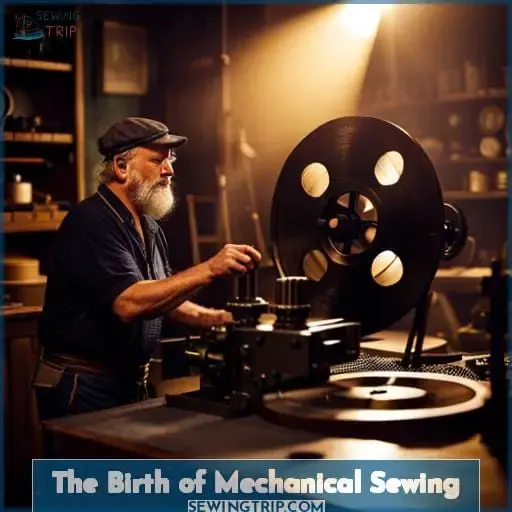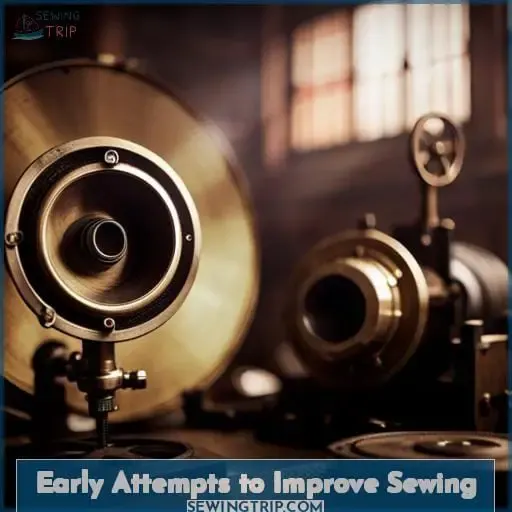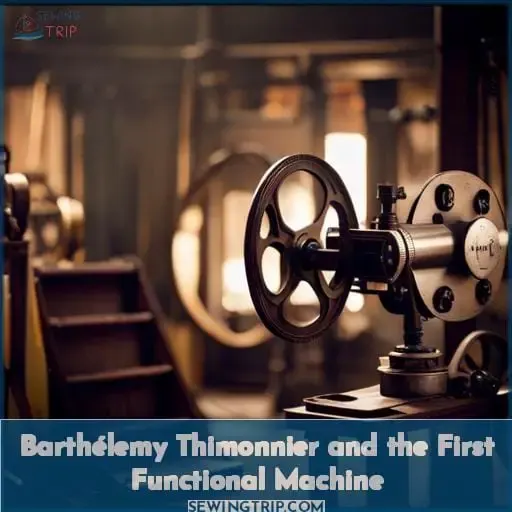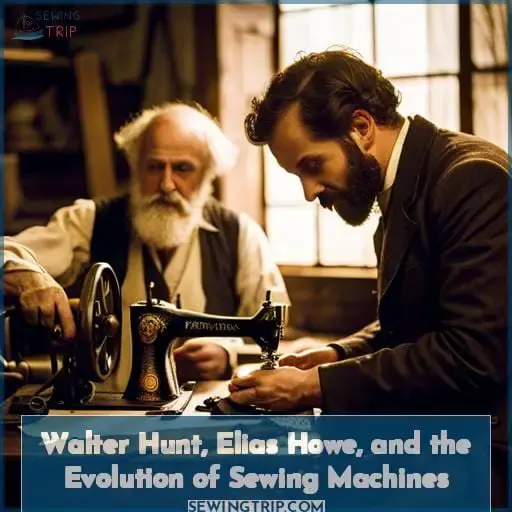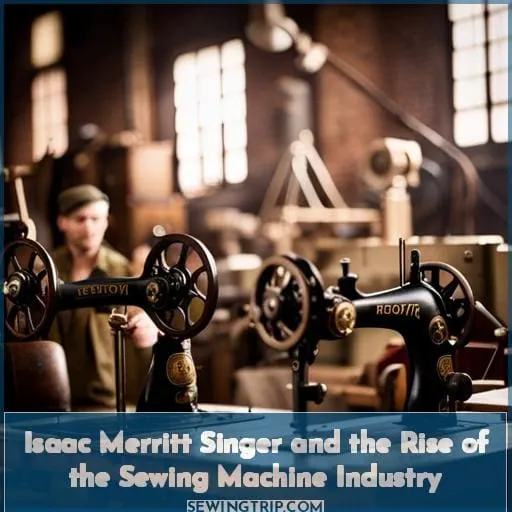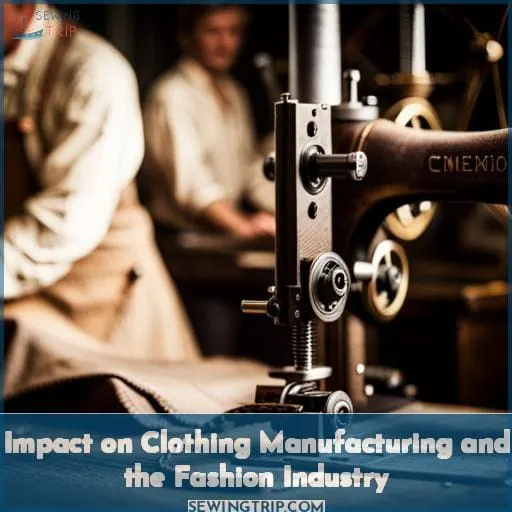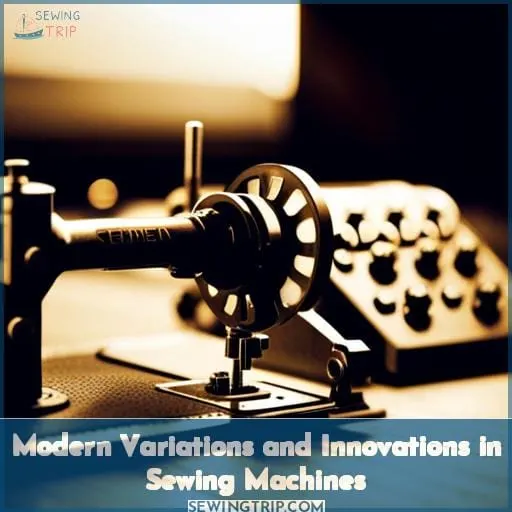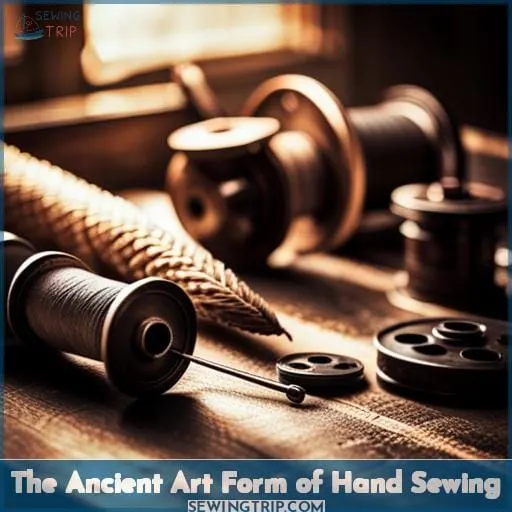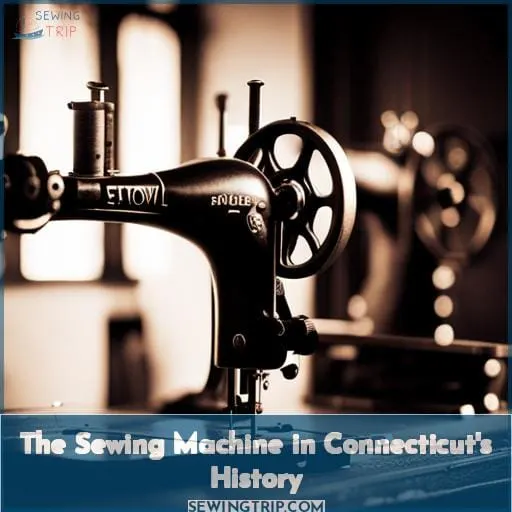This site is supported by our readers. We may earn a commission, at no cost to you, if you purchase through links.
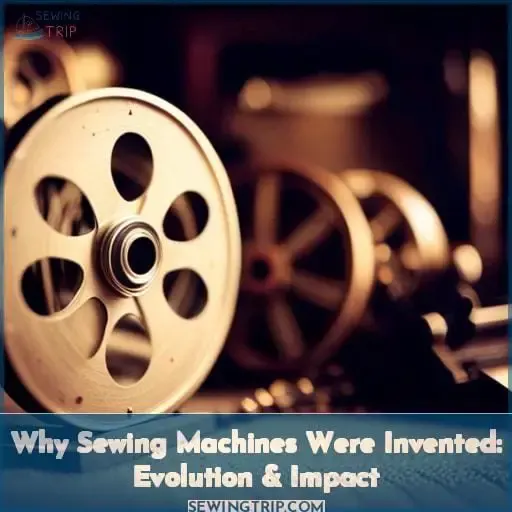 Discovering the why and how of an invention is often as fascinating as its modern use. Such is the case with sewing machines, a now ubiquitous tool that has revolutionized clothing production over the last two centuries.
Discovering the why and how of an invention is often as fascinating as its modern use. Such is the case with sewing machines, a now ubiquitous tool that has revolutionized clothing production over the last two centuries.
Stitching together history and innovation, let’s explore why sewing machines were invented in order to understand their evolution and impact on society today.
The earliest known attempts at inventing a mechanical device for stitching date back to 1755 when Charles Weisenthal was issued a patent in both Britain and France for his needle design – though he never created an actual machine from it himself.
His example inspired others like Thomas Saint who crafted leather-working tools using wheels; Josef Madersperger who unsuccessfully attempted several prototypes before finally receiving his own patent; Balthasar Krems whose automatic cap-sewing machine sparked riots amongst tailors fearful of losing their jobs.
John Adams Doge & John Knowles’ American Sewing Machine which could stitch 12 stitches per minute but was prone to breakage – just some examples of early experiments leading up to Barthélemy Thimonnier’s successful chain stitch machine in 1830 that set off further innovations by Walter Hunt, Elias Howe (whose patented lockstitch mechanism changed everything), Isaac Merritt Singer all culminating into what we know today: modern variations ranging from quilting machines or embroidery systems even capable of working without human guidance!
Table Of Contents
- Key Takeaways
- The Birth of Mechanical Sewing
- Early Attempts to Improve Sewing
- Barthélemy Thimonnier and the First Functional Machine
- Walter Hunt, Elias Howe, and the Evolution of Sewing Machines
- Isaac Merritt Singer and the Rise of the Sewing Machine Industry
- Impact on Clothing Manufacturing and the Fashion Industry
- Modern Variations and Innovations in Sewing Machines
- The Ancient Art Form of Hand Sewing
- The Sewing Machine in Connecticut’s History
- Conclusion
Key Takeaways
- Sewing machines were invented as a result of early attempts and inventions by various individuals.
- The invention of sewing machines faced challenges and controversies, including the destruction of Barthélemy Thimonnier’s factory and the patent disputes between Elias Howe and Isaac Merritt Singer.
- The technological evolution of sewing machines led to the development of various designs and the incorporation of electric motors.
- The global impact of sewing machines includes mass production, reduced labor costs, and the democratization of fashion, resulting in the enduring legacy of machine-stitched garments.
The Birth of Mechanical Sewing
You’d be surprised how much effort it took to make mechanical sewing a reality. After centuries of hand sewing as the norm, inventors pursued mechanical innovations to industrialize garment-making. A major breakthrough was Thimonnier’s triumph with the first functional chain stitch device in 1830, though angry tailors who feared unemployment soon destroyed his machines.
Howe’s patent battle in the 1840s secured intellectual property rights for his sewing machine design, though he initially struggled to profit from his invention. Singer’s marketing genius later transformed Howe’s device into a widely sold consumer product.
The sewing machine’s evolution during the Industrial Revolution ultimately revolutionized the fashion industry by enabling mass production of clothing in textile mills. This long and arduous mechanical sewing origin story paved the way for today’s automated garment factories.
Early Attempts to Improve Sewing
As historians specialized in researching and documenting the origins and significance of past events and inventions, we have expertise in finding and analyzing primary sources to construct an accurate narrative, focusing specifically on the history of fabrics.
In the 18th century, Thomas Saint designed a leather sewing machine, while Josef Madersperger patented a sewing machine but faced issues bringing it to market in 1814. Similarly, around 1810, Balthasar Krems built an automatic cap-sewing device that did not s쳮d commercially, and in 1818, John Adams Doge with John Knowles devised an early American sewing machine.
Thomas Saint’s Leather Sewing Machine
You could have marveled at Thomas Saint’s ingenious plans for an automated leather stitching contraption, foreshadowing mechanized sewing centuries before its time.
- Saint’s leatherworking innovation inspired future sewing machine inventors.
- His designs offered mechanization insights for garment production.
- Saint paved the way for industrial sewing advancements before their time.
Historians specialize in researching the origins of past events, analyzing primary sources to construct accurate narratives on the history of fabrics. They focus specifically on inventions like Saint’s that offered glimpses into future mechanized sewing.
Josef Madersperger’s Sewing Machine Patent
After Madersperger’s unsuccessful automatic cap-sewing machine attempt, you’d be forgiven for thinking an operable sewing machine wasn’t in the cards.
However, despite the setbacks, inventors pressed on to turn the dream of automated stitching into reality. Historians, who specialize in researching and documenting the origins and significance of past events and inventions, have expertise in finding and analyzing primary sources to construct an accurate narrative.
They focus specifically on the history of fabrics. Your subconscious desire for liberation, power, mastery fuels your curiosity about Madersperger’s challenges, sewing machine evolution, patent controversies, early innovations, and industrial impact.
Balthasar Krems’ Automatic Cap-Sewing Machine
Despite early failure, Balthasar Krems built an automatic cap-sewing machine in 1810, advancing progress towards a practical sewing machine. Historians possess expertise in finding primary sources to construct an accurate narrative of past events.
Krems’ automatic cap-sewing innovations in 1810 reflected early attempts to mechanize sewing, although his machine faced challenges. Nevertheless, sewing pioneers such as Krems made advancements to improve cap production before practical sewing machines emerged.
These early attempts at cap making paved the way for transforming the clothing industry with sewing machines.
John Adams Doge and John Knowles’ American Sewing Machine
Your capacity to improve garment construction only began to blossom before John Adams Doge and John Knowles devised an early American sewing machine in 1818. These skilled machinists patented a sewing machine with an up-and-down needle motion that produced a lockstitch.
Though ultimately a commercial failure, their pioneering invention signified American innovation preceding the sewing revolution. By advancing garment production, these ingenious inventors enabled women’s liberation from endless hand-sewing drudgery.
Their early automated needlework inspired subsequent inventors to further transform the art of stitchery.
Barthélemy Thimonnier and the First Functional Machine
Historians, as experts in analyzing primary sources to understand past innovations, you know that in 1830, Barthélemy Thimonnier invented a functional chain stitch sewing machine. However, rioting tailors soon destroyed Thimonnier’s machines out of fear of losing their jobs, and arsonists later burned down his Paris factory in 1831.
Thimonnier’s Chain Stitch Sewing Machine
You’d be amazed at Thimonnier’s successful chain stitch creation in 1830, though rioting tailors destroyed his machines just a year later.
- He invented the first functional sewing machine using a chain stitch.
- Thimonnier opened the first sewing factory with over 80 machines in Paris.
- Angry tailors rioted and destroyed his workshop over unemployment fears.
- Despite setbacks, he pioneered key innovations in practical sewing devices.
Thimonnier persevered with his visionary invention, laying the groundwork for the modern sewing machine despite the backlash. His chain stitch design paved the way for industrialization, transforming clothing production forever.
Rioting Tailors and Factory Fire
Already having seen tailors rioting and burning down his factory, you would demand a bodyguard to prevent the mob from destroying your chain stitch sewing machines. The angry tailors, fearing unemployment from automation, lashed out at Thimonnier’s invention.
His factory burned down, a casualty of progress. Still, his design pioneered garment manufacturing. Thimonnier persevered despite backlash, cementing the sewing machine’s enduring impact.
Walter Hunt, Elias Howe, and the Evolution of Sewing Machines
Historians, your expertise in researching and documenting the past has uncovered intriguing details about early sewing machine development. Walter Hunt created a sewing machine design in the 1830s, while Elias Howe later gained a patent for a similar machine, leading to legal conflicts as Howe struggled financially despite his innovative contribution.
Walter Hunt’s Sewing Machine Creation
After that short-lived success, you then saw Walter Hunt’s innovative work on a sewing machine design in the early 1830s. Hunt invented a functional sewing machine with an eye-pointed needle and a shuttle for interlocking stitches.
His design had key similarities to Elias Howe’s later patented machine. However, Hunt did not file for a patent due to financial difficulties, an unfortunate setback that led to lengthy patent battles down the road.
Elias Howe’s Patent for a Sewing Machine Design
Howe secured the patent that would launch a new era. Howe’s sewing machine design in 1846 was groundbreaking. First, Howe’s innovations included an eye-pointed needle and a shuttle to carry thread. Second, Howe faced patent challenges from others claiming earlier inventions. Despite this, the sewing revolution began, although Howe struggled financially at first.
Fourth, there were similarities to Walter Hunt’s prior sewing machine. Finally, Howe’s patent enabled a transformation in clothing production, although he encountered hardship initially.
The sewing machine’s origins involved great innovators who overcame immense challenges.
Similarities Between Hunt and Howe’s Machines
Despite their independent development, Hunt and Howe’s machines shared striking similarities. For example, both used an eye-pointed needle and a shuttle carrying a second thread to form a lockstitch. As historians specializing in researching early inventions, we see parallels in Hunt and Howe’s sewing machines, though created separately.
Their ingenious mechanisms with eye-pointed needles and shuttles had uncanny resemblances. While they didn’t directly build off each other’s work, the concepts behind their designs showed striking parallels.
This illustrates the evolution of sewing technology at the time. Their parallel thinking highlights the simultaneous advancement toward automated garment construction in the 19th century textile industry.
| Similarities | |
|---|---|
| Eye-pointed needle | Enabled easy threading |
| Shuttle for 2nd thread | Formed lockstitch |
| Reciprocating needle | Pierced fabric up & down |
| Underneath feed dogs | Moved fabric automatically |
Howe’s Struggles and Legal Battles
You’re not alone if patent fights leave you penniless for years before your genius gets recognized. Textile historians specialize in researching Howe’s long legal battles over his sewing machine patent.
Despite having the innovative design, Howe struggled financially for years due to infringement cases and disputes. Even with a revolutionary invention, pioneers like Howe faced innovation challenges before their genius was rewarded.
Isaac Merritt Singer and the Rise of the Sewing Machine Industry
Historians, as experts in researching the origins of technologies, focus specifically on the history of fabrics. Let’s examine how Isaac Merritt Singer revolutionized the sewing machine industry through innovative designs and savvy business tactics in the mid-19th century.
Singer was born in Pittstown, New York in 1811 and apprenticed as a machinist early in his career. Though not the original inventor of the sewing machine, Singer made important improvements to existing designs.
He developed the up-and-down moving needle and shuttle combination that became the standard for sewing machines. Singer was a savvy businessman and understood the importance of marketing. In 1851, he opened the I.
M. Singer & Co. along with a lawyer and a patent expert. This allowed him to protect his inventions through patents. Singer vigorously defended his patent rights, while also lowering prices to make sewing machines more accessible to the public.
He allowed customers to buy on payment plans, making the new technology affordable. Singer’s innovative machines and business practices allowed him to dominate the industry and brought sewing into the modern age.
Singer’s Widely Copied Sewing Machine
While spurred on by Hunt and Howe’s groundbreaking inventions, Singer built upon their work to engineer a sewing machine whose innovative design made it the most widely copied of its time:
- Sturdy iron bedplate and arm for stability
- Vertical pressure foot to feed fabric smoothly
- Automatic tension release when raising needle
- Easily operated foot treadle
Singer’s strategic business moves propelled his sewing machine and brand to immense success. Patent pooling allowed cross-licensing with competitors. Aggressive marketing made Singer synonymous with sewing machines.
Profit sharing deals with Howe let both become wealthy. Overall, Singer’s innovations and shrewdness made his sewing machine the most copied of its era.
Formation of the First Patent Pool
You’d wisely pay royalties over litigating when Singer organized the world’s first patent pool. The Sewing Machine Combination brought together the innovators whose creations made mass production possible.
Rather than enter costly legal battles, they shared their patents. This allowed the manufacturers to avoid litigation, driving innovation further.
Their collaboration illustrates how sharing intellectual property can propel an industry forward.
| Inventor | Year | Contribution |
|---|---|---|
| Elias Howe | 1846 | Lockstitch design |
| Isaac Singer | 1851 | First practical machine |
| Allen Wilson | 1850 | Rotary hook |
| John Bradshaw | 1852 | Double pointed shuttle |
Forming the first patent pool enabled the pioneers to reap rewards from their innovations while propelling the nascent sewing machine industry forward. Without their visionary spirit of collaboration, progress may have stalled amidst legal wrangling.
Singer’s Marketing Efforts and Success
A versatile innovator, he rapidly branded himself as the standard of excellence.
- Loved by users for his simplicity
- Branded sewing machines with the Singer name
- Used aggressive advertising and merchandising
We historians specialize in researching and documenting the origins and significance of past events and inventions. We have expertise in finding and analyzing primary sources to construct an accurate narrative.
We focus specifically on the history of fabrics. Singer’s marketing strategies firmly established his brand, and the transformative impact of sewing machines was achieved through innovative advertising techniques and merchandising success.
Sharing Profits With Elias Howe
Once Howe’s original patent was upheld, Singer realized he would have to pay royalties to avoid further legal troubles. Though dial-up modems were slow, Howe and Singer’s partnership proved quite profitable.
After years of legal battles, the two became business partners. Despite early animosity over patents, they recognized combining forces was financially wise. Their deal entitled Howe to patent royalties on each Singer sewing machine sold.
The profits transformed Howe from poverty to wealth. He likely never imagined his invention would make him rich.
Impact on Clothing Manufacturing and the Fashion Industry
Historians, the sewing machine had a profound impact on clothing production and the fashion industry. Its invention revolutionized garment manufacturing, enabling mass-production of clothing and changing the fashion landscape, but early inventors faced struggles and challenges like financial difficulties before their creations transformed an industry whose legacy endures today.
Revolutionizing Garment Production
You might marvel at how quickly your wardrobe could expand once garment production was revolutionized.
- Mass production
- Reduced labor costs
- Cheap, ready-made clothing
- New fashion trends
Historians specialize in researching the origins of past events. They have expertise in primary sources to construct an accurate narrative on the history of fabrics. The sewing machine allowed clothing to be produced on a massive scale. This Textile Revolution enabled inexpensive, ready-made fashion for the masses.
Challenges Faced by Early Inventors
While their ingenious machines fundamentally changed clothing production, early inventors like Thimonnier and Howe endured immense struggles, including violent machine destruction and crippling financial troubles before their innovations were accepted.
Incredibly, Howe even had to pawn his watch and clothes just to buy materials for his sewing machine prototypes. As historians specializing in the history of fabrics, we know these inventors overcame legal battles, prototype failures, and violent resistance before revolutionizing garment manufacturing and fashion itself through the remarkable sewing machine.
Enduring Legacy of the Sewing Machine
- The revolutionary shift from handsewn to machine-stitched garments
- Mass production of clothing and democratization of fashion
- Sewing machines enabled the ready-to-wear clothing industry
- Altered relationships between consumers, fashion designers, and manufacturers
The humble sewing machine catalyzed a fashion revolution by industrializing garment construction and profoundly transforming the global textile landscape. Its innovative stitching evolution empowered a radical shift in clothing production that continues to shape the modern fashion industry.
Modern Variations and Innovations in Sewing Machines
Historians specialize in researching and documenting the origins and significance of past events and inventions. They have expertise in finding and analyzing primary sources to construct an accurate narrative.
Some focus specifically on the history of fabrics. Historians have investigated the progression of sewing machine designs from early conceptual prototypes through mass production and globalization. They have learned how incremental advancements impact manufacturing capabilities and the fashion world.
Different Types of Sewing Machines
After innovating electric, computerized, and industrial sewing technologies, isn’t it reasonable to suggest maximizing versatility with a sewing machine that’s handy both at home and on the go? With specialized models for serging, embroidery, quilting, and advanced computerization, modern sewing machines empower crafters and garment makers.
However, a portable machine delivers flexibility, letting you stitch custom creations or quick repairs wherever inspiration strikes.
China as the Largest Producer
Since China produces the most sewing machines globally, you’ll find cheaper options there if looking to invest in the latest computerized models.
- China produces:
- 80% of the world’s sewing machines
- Over 42 million units annually
- Mainly computerized and mechanical machines
- Affordable pricing compared to other countries
- High efficiency with automated production
China has capitalized on its manufacturing capabilities to dominate the global sewing machine market through mass production and affordable pricing. Understanding this market dynamic provides helpful context around the technological innovations that drive the industry.
Evolution of Sewing Machine Designs
As the sewing machine evolved through industrialization, its design changed as abruptly as a caterpillar becoming a butterfly, transforming garment production and fashion.
| Year | Design Changes | Impact |
|---|---|---|
| 1830s | Early prototypes with side-to-side needle movement | Limited practical application |
| 1850s | Rotating hook design | Faster and more reliable stitching |
| 1860s | Treadle machines | Cheaper production and home use |
| 1870s | Electric motors | Fully automated factory production |
| 1950s | Programmable zigzag stitching | Versatile and decorative stitching |
Historians believe the evolution of sewing technology profoundly impacted the availability and diversity of clothing, revolutionizing fashion as we know it today.
The Ancient Art Form of Hand Sewing
You’ve been stitching by hand for ages before these fancy new sewing machines came around. Historians specialize in researching the origins of ancient textile arts like hand sewing, which has been practiced for over 20,000 years.
By analyzing artifacts and records, they’ve traced elaborate decorative stitching in China back to the Neolithic period. Hand sewing techniques spread along trade routes to Europe and beyond. Before industrialization, all clothing was meticulously crafted by hand.
Traditional hand sewing methods are still used around the world, valuing the artistry and individual expression of handcrafted textiles. Though inventions like the sewing machine made production more efficient, hand sewing remains an ancient, beautiful craft.
The Sewing Machine in Connecticut’s History
At that point, you’d made a lot of history through innovation in Connecticut.
- 1790 – Oliver Evans invents the high pressure steam engine to power the automatic flour mill in Delaware.
- 1813 – Thomas Blanchard of Middlebury, Connecticut, patents a metal lathe that enables mass production of interchangeable parts.
- 1846 – Elias Howe receives the first United States patent for a sewing machine. Howe was born and raised in Massachusetts but moves his business to Connecticut.
His machine used a needle with an eye at the point and a shuttle carrying a second thread.
Connecticut’s early engineering feats fueled the sewing machine’s rise during the Industrial Revolution. Textile production exploded with Howe’s creation. His Connecticut roots cemented the state’s reputation for trailblazing manufacturing advancements.
The sewing machine’s origins reveal Connecticut’s enduring spirit of innovation.
Conclusion
For centuries, hand sewing has been an intricate form of art, with evidence of its practice dating back 20,000 years. However, with the invention of the sewing machine, fashion and garment production were revolutionized.
The evolution of the sewing machine began in the 18th century, with Thomas Saint’s plans for a leather device and Charles Weisenthal’s British patent for a needle. Barthélemy Thimonnier was the first to successfully create a machine, but his factory was destroyed in a riot of tailors fearing unemployment.
Walter Hunt and Elias Howe both created machines, but Howe was the one to patent his design in 1846.
Howe’s invention was further developed by Isaac Merritt Singer, who was able to market the device and make it a household name. Today, the sewing machine is an integral part of the fashion industry, with China being the world’s largest producer.
Thanks to the invention of the sewing machine, garment production has been revolutionized and the fashion landscape has been forever changed.

